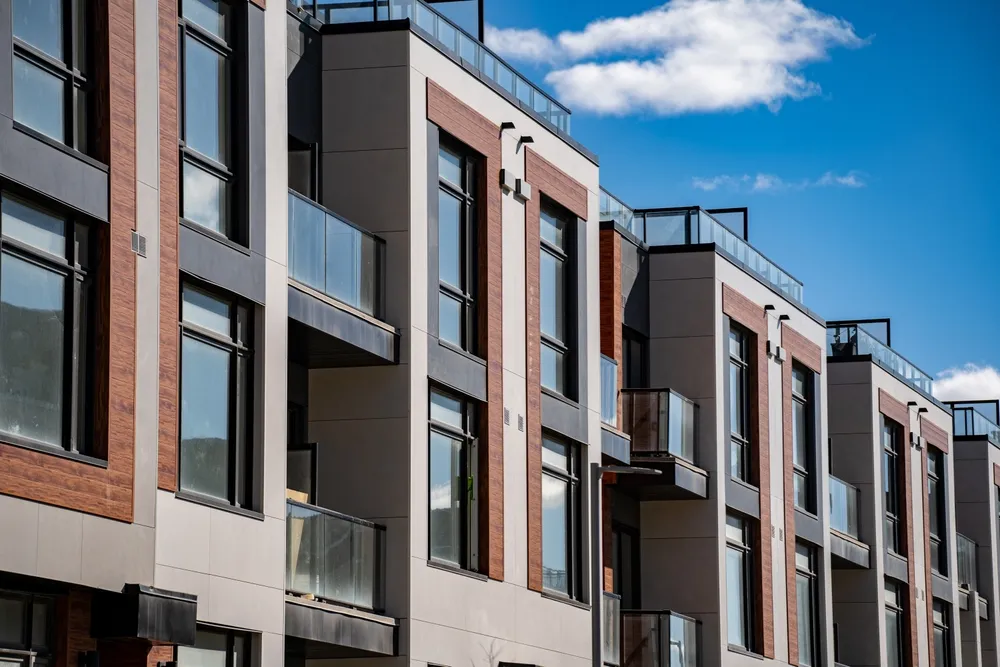The U.S. multifamily market has always been the dependable cornerstone of commercial real estate investing — a sector defined by demographic strength, resilient income, and deep capital liquidity. But as 2025 unfolds, the industry stands at a critical inflection point. A massive wave of loan maturities — what analysts have dubbed the “CRE maturity cliff” — is reshaping how investors and lenders think about risk, leverage, and timing.
While headlines often center on office distress, multifamily’s maturity wall is arguably more consequential: the sector holds nearly 40% of all CRE loans set to mature in 2025, according to Moody’s Analytics. With refinancing conditions tightening and interest rates still far above their 2021 lows, thousands of sponsors are discovering that rolling debt won’t be simple, or cheap.
For those prepared to navigate the turbulence, however, opportunity abounds. Transitional financing — particularly bridge debt and structured capital — has reemerged as the crucial link between distress and stability.
The Debt Wall: Scale, Pressure, and Market Response
According to Trepp, roughly $900 billion in commercial mortgages are scheduled to mature in 2025, a record-setting volume that underscores the capital challenges facing the industry. Multifamily represents the single largest slice of that total, with much of it financed during the low-rate window of 2019–2021. As those loans reset today at rates often 300–400 basis points higher, the cash flow math simply doesn’t hold.
The National Multifamily Housing Council (NMHC) notes that debt service coverage ratios have compressed sharply across Class B and C properties, where rent growth has softened but expenses — particularly insurance, utilities, and maintenance — continue to climb. Cap rates, meanwhile, have expanded to roughly 5.6% nationally, per CBRE’s Q2 2025 U.S. Cap Rate Survey, compared with 4.2% two years earlier.
That widening spread between asset yields and borrowing costs has made traditional refinancing — whether through agencies like Fannie Mae or banks — far more constrained. JLL’s midyear capital markets outlook found that agency origination volume in multifamily is down nearly 20% year-over-year, while life companies and CMBS channels remain cautious, focusing almost exclusively on core assets with strong in-place cash flow.
In short: the refinancing pipeline is tight, and billions in loans are rolling off into a tougher credit world.
Bridge Lending Returns to Center Stage
When permanent capital retreats, bridge capital steps forward. Bridge loans — typically 12 to 36 months in term — have become the default tool for borrowers navigating maturities or executing value-add business plans.
According to CBRE’s 2025 Capital Markets Snapshot, bridge loan originations for multifamily assets increased 28% year-over-year, with spreads compressing as more private lenders, debt funds, and institutional platforms reentered the market. Average pricing now ranges between SOFR + 275 and 325 basis points for stabilized or light-transitional assets, with leverage up to 80% of cost for stronger sponsors.
Private credit is driving much of this activity. The Real Deal reports that private-debt vehicles raised over $78 billion in 2024 dedicated to CRE bridge strategies, much of it targeting multifamily repositionings and refinancing gaps. Lenders are structuring deals with greater flexibility — including interest reserves, extension options, and performance triggers — to help sponsors weather rate volatility.
The dynamic is clear: bridge lenders are no longer niche participants. They are the liquidity engine sustaining multifamily capital markets during a prolonged period of repricing.
Market Stress, Hidden Opportunity
Yet for all the liquidity bridge loans offer, not all borrowers can absorb the cost. For transitional assets with lower in-place yields or for Class C properties in softening submarkets, debt costs can outpace cash flow. The result is an uptick in “extend and amend” negotiations, where lenders provide short-term extensions in exchange for partial paydowns or capital injections.
GlobeSt notes that as much as 30% of multifamily bridge loans maturing in 2025 may require modifications to avoid technical default. Meanwhile, opportunistic investors — particularly private equity groups and family offices — are circling distressed or over-levered assets, often partnering with bridge lenders to execute recapitalizations.
This environment, while challenging, is also rich with potential. For well-capitalized sponsors, the next 12 months could mark the most attractive entry window in a decade. Cap rates have stabilized, construction pipelines are slowing, and competition from new supply is easing. Marcus & Millichap projects that multifamily completions will fall by nearly 40% in 2025, allowing fundamentals to recover just as distress-driven opportunities hit the market.
In other words, for investors with flexible capital and the ability to execute creative financing — bridge loans, preferred equity, or rescue capital — 2025 offers both defensive and offensive plays.
The New Structuring Mindset
The past two years have redefined how sponsors think about capital structure. Where once the goal was maximum leverage at minimal cost, today’s focus is balance, flexibility, and optionality.
Cushman & Wakefield’s “Midpoint 2025 Outlook” highlights a sharp increase in hybrid structures that blend senior bridge debt with subordinate tranches — mezzanine loans, preferred equity, or even convertible components. The aim: to maintain liquidity while controlling dilution.
This “stack engineering” is becoming an art form. Debt funds willing to underwrite deeper into the capital stack can now command premium pricing, while borrowers gain breathing room to stabilize NOI or reposition assets.
For example, a sponsor facing a $20 million maturing loan might refinance with a $15 million senior bridge loan (SOFR + 300 bps) and a $3 million preferred equity layer yielding 10–12%. The remaining gap can be filled with fresh sponsor capital or co-GP equity. Such structures keep control with the owner, preserve upside, and align incentives for all parties — a hallmark of modern CRE finance strategy.
Regional Variations and Market Selection
Bridge and refinance dynamics vary widely by geography. Markets with strong in-migration and job growth — such as Dallas–Fort Worth, Phoenix, and Orlando — continue to attract competitive bridge terms. Lenders remain comfortable underwriting to stabilized pro formas given clear absorption trends.
In contrast, coastal gateway markets like San Francisco, Los Angeles, and Washington, D.C. face slower rent growth and heavier regulatory constraints, which translate into higher risk premiums. Even within metros, performance diverges sharply by submarket: suburban Class A assets are faring better than urban Class B stock with higher vacancy.
CBRE’s 2025 U.S. Multifamily Outlook forecasts national rent growth of 2.7%, but warns that Class C and rent-controlled units will continue to lag due to affordability limits and operating expense pressures. For lenders, that means underwriting with greater granularity — down to block-level economic health, not just city averages.
The Role of Institutional Capital and Securitization
While banks remain on the sidelines, institutional capital is quietly returning through debt fund partnerships and collateralized loan obligations (CLOs) backed by bridge debt. According to Moody’s, multifamily assets account for more than 60% of CRE CLO collateral issued in early 2025, signaling renewed investor appetite for short-term floating-rate exposure now that spreads have widened.
This trend matters because it restores liquidity to the bridge market. As funds securitize seasoned loans, they recycle capital into new originations, sustaining deal flow even as banks deleverage. It also introduces more competitive pricing and standardized documentation, narrowing the gap between private and institutional credit.
The Human Factor: Execution and Relationship Capital
In turbulent markets, execution is everything. Borrowers with deep lender relationships, transparent reporting, and proactive asset management are finding that capital is still available — just more selective. Lenders are increasingly rewarding communication and performance discipline.
As Bisnow recently observed, “In 2025, the real differentiator in multifamily lending isn’t cost of capital — it’s credibility of execution.” In this sense, bridge and refinancing markets are as much about relationship capital as financial capital.
Outlook: From Survival to Strategy
Looking ahead, the multifamily sector is unlikely to experience a systemic crash. Demand fundamentals remain strong, underpinned by housing shortages, demographic tailwinds, and the affordability gap between owning and renting. But liquidity stress will continue to shape behavior.
Expect 2025 to remain a year of “creative survival” — sponsors stabilizing assets through short-term capital and opportunistic investors capitalizing on distress. By 2026, as interest rates normalize and inflation retreats, today’s bridge borrowers could emerge as tomorrow’s consolidation winners.
F2H Capital Group’s Perspective
At F2H Capital Group, we view this cycle not as a crisis but as a strategic reset — one where financing creativity defines investment success. Our platform is designed to provide the structured solutions this moment demands:
- Bridge financing for multifamily sponsors facing loan maturities or transitional repositionings.
- Structured debt and preferred equity for acquisitions or recapitalizations requiring layered capital.
- Advisory and execution expertise that align underwriting precision with sponsor vision.
In a market defined by uncertainty, agility is alpha. By combining data-driven underwriting, disciplined leverage, and a partnership mindset, F2H Capital Group helps clients bridge the gap between disruption and opportunity — turning 2025’s maturity cliff into a launching pad for long-term growth.
Sources:
CBRE U.S. Cap Rate Survey, JLL Capital Markets Outlook, Moody’s Analytics CRE Outlook 2025, The Real Deal, GlobeSt, Cushman & Wakefield, Trepp, Marcus & Millichap, Bisnow

.png)

.png)